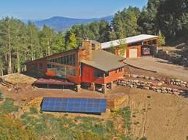
Nice place but pricey A multimillion-dollar house on the back of Aspen Mountain went on the market this summer. Is there such a thing as an Eco McMansion?
The 3,600 square feet house on the New York Lode patented mining claim is completely off the grid, with a geothermal system providing hot water for heating and domestic use, and a five-kilowatt solar photovoltaic system providing the electricity.
Architect Dean Moffatt always envisioned “an uncompromised, cutting-edge project,” he said.
His friend, Stirling “Buzz” Cooper, wanted to sell the 9.5-acre New York Lode, located about three-quarters of a mile off Midnight Mine Road. Cooper had previously received one of the last approvals to build a house in backcountry lands that Pitkin County has since rezoned “Rural and Remote.” Only small cabins are now allowed on those type of parcels.
Moffatt visited the site with his friend and immediately saw its potential. “It is a golden opportunity for a totally off-grid, state-of-the-art house,” he said.
He bought the land, came up with a plan, and stared chipping away at construction in 2006 with his son, Nathan. They were challenged by short construction seasons at the site at about 10,000 feet high. The eco-house came together this summer. Moffatt employed all the green gadgets, designs and philosophies that he has worked with or imagined over the years.
“We didn’t spare the horses on the technology,” he said.
The geoexchange system pumps water into the ground and circulates it back to a ground-source heat pump that absorbs the heat and transfers it to the house. The same system is used to cool the house in the summer.
The southern exposure provides awesome views of Conundrum Valley and Hayden Peak, and assists with passive solar heating. The south wall is loaded with windows and boast a commercial-quality glass curtain wall like those used in skyscrapers. Special glazing allows heat to come in but won’t let it escape.
The solar photovoltaic system feeds a bank of batteries that can store enough electricity to power the house for up to five days.
The Moffatts also used green building techniques, like structural insulated panels, which sandwich rigid foam plastic insulation between two structural skins. The pre-made panels were hauled to the site for use in the floors, walls and roof. Heavy timber for the frame was milled and custom cut in British Columbia from standing dead Douglas fir. No live trees were chopped down to provide lumber for the house, Moffatt said.
The interior boasts all the qualities of a modern, environmentally friendly house, such as Energy Star appliances, which signify energy efficiency, dual flow toilets and low off-gassing paints.
Despite all the green attributes, the question remains, can a 3,600-square-foot house built in a secluded wildflower meadow high up in the Colorado mountains really be considered ecologically friendly? The house is located 5.6 miles from Aspen’s roundabout. Midnight Mine Road isn’t plowed high enough to provide access to the driveway, so the New York Lode is accessible during winter months only by snowmobile or Snocat, which is included in the $5,675,000 sales price.
A real estate sales brochure notes that the property “can easily accommodate a helicopter landing site.”
“Is there a certain level of hypocrisy in this?” Moffatt asked. Of course there is, he answered. There is some level of hypocrisy in any development, even those that accomplish green goals.
He looks at it this way: The property had development approvals, and the driveway already existed off of Midnight Mine Road. It wasn’t a question of whether the New York Lode would be developed, just when. Moffatt believes the house he built was best for the site. It’s clean, non-polluting and inconspicuous. He considers is a convergence of green ideas.
“It’s not in anyone’s face, and it’s secluded unless you fly over it,” he said.
Information on the house is available at www.newyorklode.com.